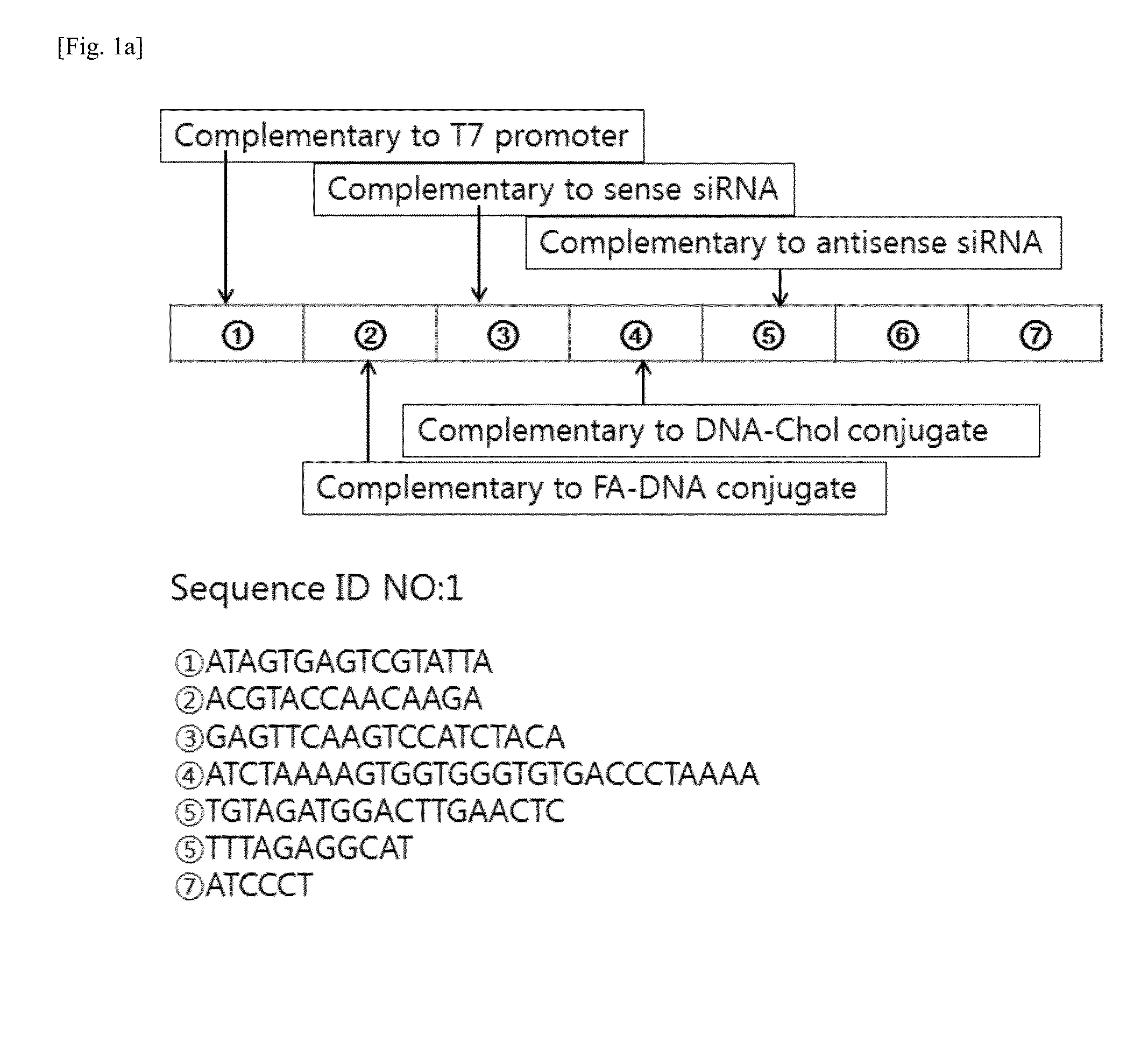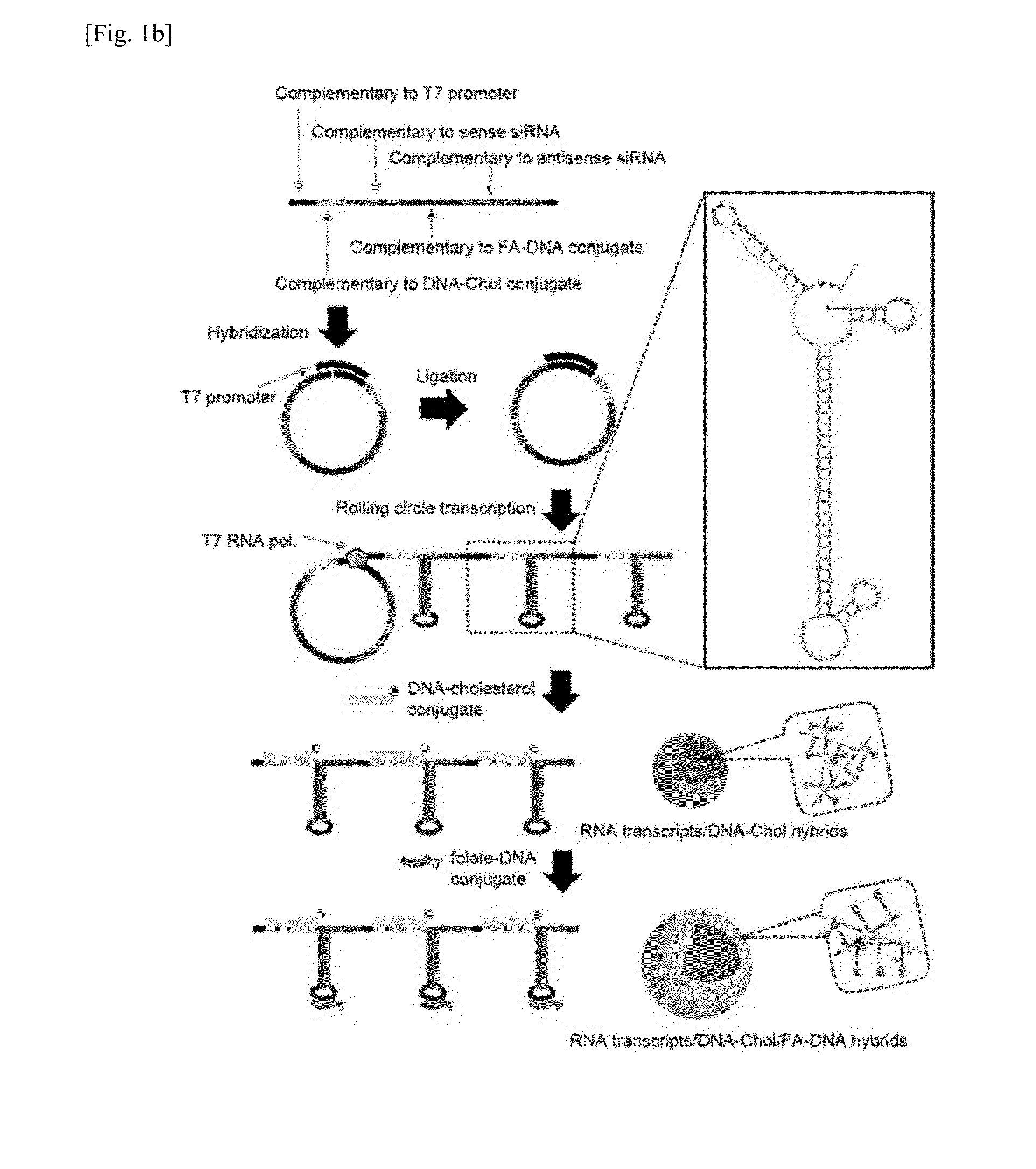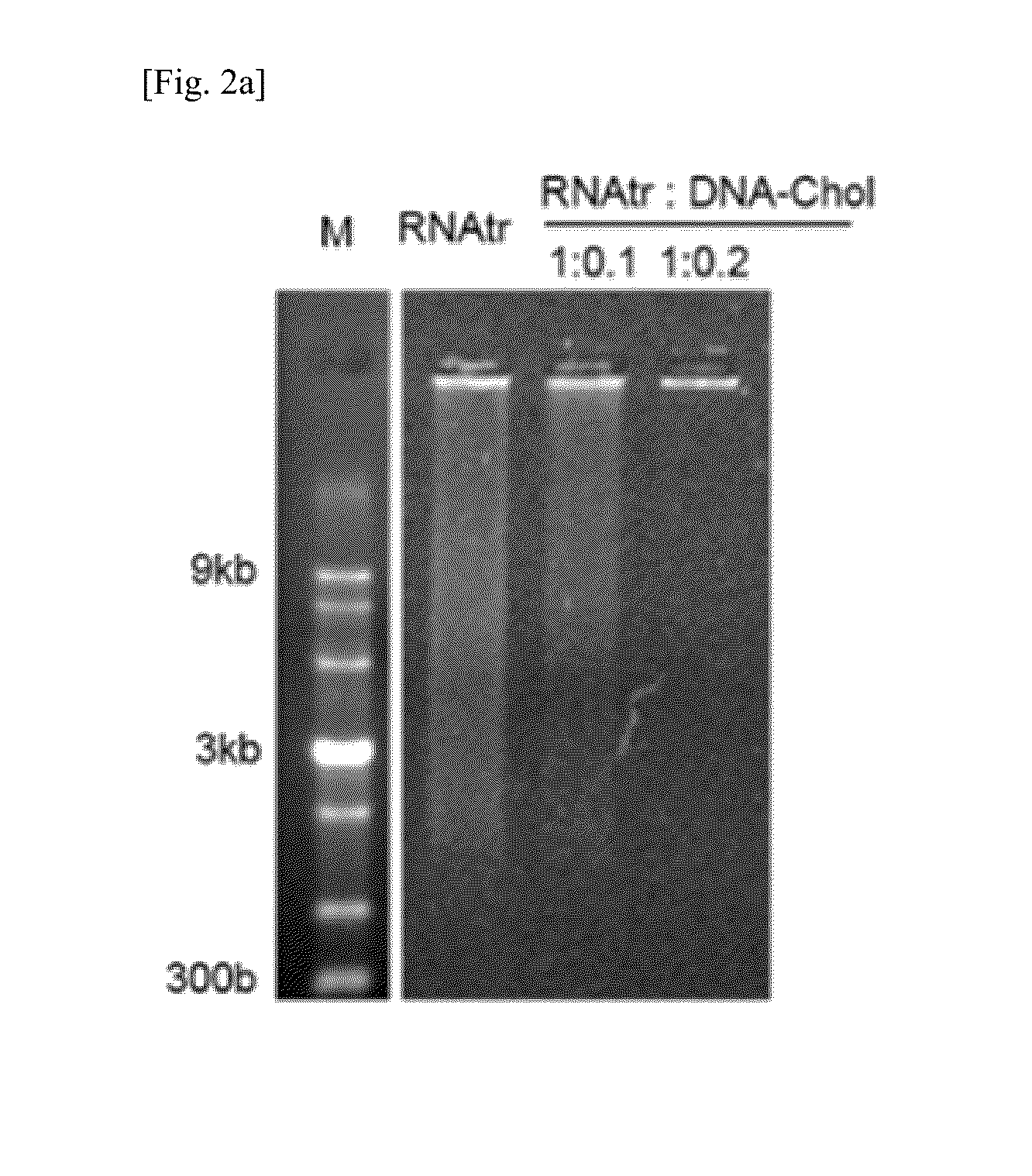RNA/DNA nanoparticle for siRNA target-specific delivery and vehicle including the same
a technology of rna/dna nanoparticles and target-specific delivery, which is applied in the field of amphiphilic rna/dna nanoparticles, can solve the problems of limited vehicle use of cationic molecules or synthetic polymers, low transmissibility into cells, and low sirna loading efficiency of vehicles, etc., to achieve excellent sirna loading efficiency, excellent biocompatibility, and secure sirna stability against external attack.
- Summary
- Abstract
- Description
- Claims
- Application Information
AI Technical Summary
Benefits of technology
Problems solved by technology
Method used
Image
Examples
example 1
Preparation of RNA / DNA Nanoparticle for siRNA Delivery
[0077]1-1. Design of RNA / DNA Nanoparticle for siRNA Delivery
[0078]The present inventors designed a linear DNA sequence (SEQ ID NO. 1), of which both ends are complementary to a T7 promoter sequence (SEQ ID NO. 4), and they also designed an RNA transcript (SEQ ID NO. 5) to be produced from DNA of SEQ ID NO. 1 as a template, in which the RNA transcript has sequences complementary to a DNA-Chol conjugate (SEQ ID NO. 2) and a folate-DNA conjugate (SEQ ID NO. 3) so as to form RNA / DNA base-pairing.
[0079]A two-dimensional structure of RNA was analyzed by RNA mfold program (http: / / mfold.rna.albany.edu / ?q=mfold / RNA-Folding-Form), and as shown in FIG. 1, numerous repeats of a hairpin structure containing siRNA sequence were observed. In this Example, a generation process of RNA / DNA nanoparticles for siRNA delivery is shown in FIG. 1b.
[0080]1-2. Preparation of RNA / DNA Nanoparticle for siRNA Delivery by RCT and RNA / DNA Hybridization
[0081]To...
example 2
Characterization of RNA / DNA Nanoparticle for siRNA Delivery
[0085]The RNA transcript, RNAtr / DNA-Chol hybrid, and RNAtr / DNA-Chol / FA-DNA hybrid prepared in Example 1-1 were electrophoresed on a 3% agarose gel (FIGS. 2a and 6b). The RNA transcript exhibited a wide molecular weight distribution, whereas the RNAtr / DNA-Chol hybrid (1:0.2, w / w) did not move from the well to the bottom while forming large particles. In particular, the results of electrophoresis showed that the size of the RNAtr / DNA-Chol hybrid (1:0.1, w / w) is placed between the RNA transcript and the RNAtr / DNA-Chol hybrid (1:0.2, w / w). FIGS. 2c, 2d and 6c show the particle size and zeta potential measured using dynamic light scattering (DLS).
[0086]The RNA transcript formed microparticles of 1 μm or larger, but the RNAtr / DNA-Chol hybrid (1:0.2, w / w) formed nanoparticles of 120 nm resulting from self-assembly. The RNAtr / DNA-Chol hybrid (1:0.1, w / w) showed a particle size of 357 nm and two size distributions in size distributio...
example 3
Stability Test of RNA / DNA Nanoparticle for siRNA Delivery
[0088]In order to examine stability of RNA / DNA nanoparticle for siRNA delivery in the blood, degradation products obtained under 30% FBS conditions over time were analyzed by electrophoresis. First, monomeric siRNA as a control group was completely degraded within 1 hour and about 80% or more of the RNA transcript was degraded after 6 hours, whereas about 65% of the RNAtr nanoparticle remained intact even after 24 hours, indicating very excellent stability against nuclease. It is understood that siRNAs located inside the RNA / DNA nanoparticle are physically protected from nuclease attacks, and in particular, folate exposed to the outside considerably blocks access of nuclease.
[0089]To examine stability against a large amount of macroanionic molecules in extracellular matrix located outside of the plasma membrane, stability of the RNAtr nanoparticle was examined under heparin condition (FIGS. 3b and 7). It was observed that when...
PUM
| Property | Measurement | Unit |
|---|---|---|
| diameter | aaaaa | aaaaa |
| diameter | aaaaa | aaaaa |
| weight | aaaaa | aaaaa |
Abstract
Description
Claims
Application Information
 Login to View More
Login to View More - R&D
- Intellectual Property
- Life Sciences
- Materials
- Tech Scout
- Unparalleled Data Quality
- Higher Quality Content
- 60% Fewer Hallucinations
Browse by: Latest US Patents, China's latest patents, Technical Efficacy Thesaurus, Application Domain, Technology Topic, Popular Technical Reports.
© 2025 PatSnap. All rights reserved.Legal|Privacy policy|Modern Slavery Act Transparency Statement|Sitemap|About US| Contact US: help@patsnap.com



